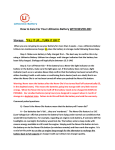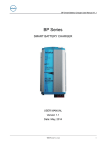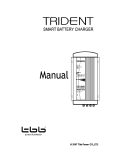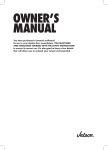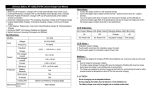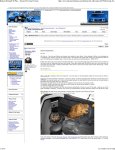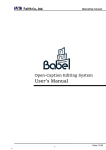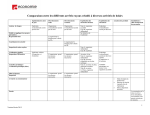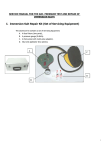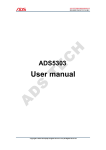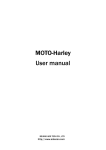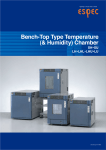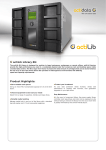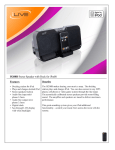Download 12V Engine Start Battery w/NeverDIE User Manual
Transcript
12V Engine Start Battery w/NeverDIE User Manual Voltage: 12.8V (Nominal), 10.8V (Min.), 14.4V (Max.) Discharge Rate: 80A Max. Continuous. 5 Second Pulse: 10C or 10 X’s Your Rated Capacity in Amp Hours. Example: a 12V40A is rated at 10 X 40 = 400 Amps Charge Rate: 1C (Max) Example: a 12V40A…MAX. Charge Rate= 1C X 40 = 40 Amps Discharge Operating Temperature Range: -4F to 140F Charge Operating Temperature Range: 32F to 113F Storage Temperature Range: -4F to 95F Water Resistant Index 1. Product Warranty 1.1 - Product Warranty 1.2 - Warranty Registration 1.3 - Terms and Conditions 2. Operating Environment 2.1 - UNDOT Specification 2.2 - Waterproof Specification 2.3 - Temperature Specification 3. NeverDIE Battery Operation 3.1 - Connecting Your NeverDIE Battery 3.2 – Terminal Tightening Torque 3.3 – NeverDIE Pushbutton operation 3.4 - Optional NeverDIE Wireless Remote Operation 4. Charging Your Battery 4.1 - Supported Chargers 4.2 - Connecting Your Battery 5. Storing Your Battery 6. Troubleshooting Lithionics Battery LLC |2013 1. Product Warranty 1.1 - Product Warranty: Warranty: 3 Years, prorated for benefit of use. 1.2 - Warranty Registration: To ACTIVATE your product warranty please visit: www.LithionicsBattery.com and click the red “WARRANTY” tab at the top, then fill out the warranty submission form and click “SUBMIT”. 1.3 - Terms and Conditions: Lithionics Battery provides a warranty to the original purchaser that this battery is free of defects in material and workmanship for 36 months indicated for each battery. LITHIONICS BATTERY WARRANTY IS LIMITED TO REPLACEMENT OF THE BATTERY ACCORDING TO THE TERMS AND CONDITIONS. LITHIONICS BATTERY WILL NOT BE RESPONSIBLE FOR ANY EXPENSES FOR INSTALLATION, TOWING, ELECTRICAL SYSTEM TESTS, CHARGING A BATTERY, LOSS OF TIME, OR OTHER EXPENSES WHICH WOULD BE CONSIDERED AS INCIDENTAL OR CONSEQUENTIAL DAMAGES. THIS WARRANTY DOES NOT COVER DAMAGE TO THE BATTERY CAUSED BY ABUSE OR NEGLECT, A FAILURE TO KEEP THE BATTERY PROPERLY CHARGED OR MAINTAINED, FIRE, COLLISION, EXPLOSION, FREEZING, THEFT, OR OVERCHARGING. The original purchaser must complete the WARRANTY REGISTRATION document that was provided with the battery during shipment. If you did not receive this document or have misplaced it, you may also register your battery on-line at www.LithionicsBattery.com. Batteries that are not warranty-registered with Lithionics Battery do not qualify for any warranty coverage. This warranty shall be IN LIEU OF any other warranty, express or implied, including but not limited to, any implied warranty of MERCHANTABILITY or fitness for a particular purpose. Note: Some states do not allow limitations on how long an implied warranty lasts, or exclusion or limitation of incidental or consequential damages, so the above limitations may not apply to you. This warranty gives you specific legal rights, and you may have other legal rights, which may vary from state to state. Seller warrants solely to the original end user. All periods described in attached warranty shall be based on the date of sale of the product. The original purchaser may obtain a replacement battery of similar size and power upon payment of a prorated charge based upon the then current published cost per month which is based on the then published List Price of the battery multiplied by the number of full months elapsed since the date of original purchase. Pro rata adjustment is based on the total months of use from the date of purchase to the date of warranty claim rounding to the nearest next month. For a warranty claim contact the dealer the battery was purchased from or contact Lithionics Battery. Lithionics Battery LLC |2013 2. Operating Environment 2.1 - UNDOT Specification: All Lithionics Batteries are tested to comply with UNDOT requirements. These include but are not limited to: • Altitude Simulation: 11.6kPa (~50,000) feet for at least 6 hours. • Thermal Test: Exposure to positive/negative temperatures above the cells rated use for 262 hours. • Vibration Test: 3 hours of a bi-directional frequency ranging from 7Hz to 200Hz. • Shock Test: Batteries < 12kg (26.45lbs) are subjected to shock of peak acceleration of 150 gn. Batteries > 12kg (26.45lbs) are subjected to a shock of peak acceleration of 50 gn. Passing criteria for the above tests is defined as: no mass loss, no leakage, no venting, no disassembly, no rupture, and no fire, and open circuit voltage must remain 90% or higher of the pre-test voltage. THIS TEST DOES NOT CERTIFY THAT YOUR BATTERIES WILL ENDURE IN THIS ENVIRONMENT….IT IS A TEST OF SAFETY TO SIMULATE CRASH CONDITIONS OR SHIPPING DAMAGE 2.2 - Water/Moisture Specification: All Lithionics Batteries are water resistant, not waterproof. This means the battery is protected against falling water when tilted up to 15 degrees in each direction from normal upright operating position. Do NOT submerge the battery as it will cause permanent damage. 2.3 - Temperature Specification: • Discharge Operating Temperature Range: -4F to 140F • Charge Operating Temperature Range: 32F to 113F • Storage Temperature Range: -4F to 140F Lithionics Battery LLC |2013 3. NeverDIE Battery Operation 3.1 - Connecting Your NeverDIE Battery • Identify the positive and negative terminals. As pictured below, note the difference between both terminals. The right terminal in this example has a stripe, this indicates the positive connection. • When opening your package, you will find that each terminal has a black and a red cap. The red indicates positive, and black indicates the negative output. Lithionics Battery caps are placed like below: • Near your battery terminals, locate the red positive symbol like this: + This symbol will always be found beside or at the bottom of the positive terminal. 3.2 - Tightening Torque: All main battery terminal connections must be tightened to a max torque value as indicated below. Do not exceed this value. Brass/copper conductors have a much lower shear strength than steel. M6 Modular Terminals 60 inch pounds/7 N-m 5/16 Bolt SAE Style Terminals 100 inch pounds/11 N-m Lithionics Battery LLC |2013 3.3 - Push Button Operation: On top of your battery is EITHER a low-profile stainless-steel pushbutton momentary switch OR a red push button which operates the batteries output. It operates simply by pushing once OR by pushing and holding the button. To turn your battery ON: Press and hold the button for 1 second and release. To turn your battery OFF: Press and hold the button for 4 seconds and release. 3.4 - Optional Wireless Remote Operation: With the optional Wireless Remote you can turn the battery on/off while being up to 100 feet away. To turn battery output ON Press the UNLOCK symbol on the remote. To turn battery output OFF Press the LOCK symbol on the remote. See Charging Next Page Lithionics Battery LLC |2013 4. Charging Your Battery 4.1 - Supported chargers: Lithionics Battery 12V engine start batteries can be charged with either a 12V rated alternator in proper working order or a Lithionics Battery LiFePO4 Charger. Failure to do so will void the battery’s warranty. Other chargers are factory approved but you must report that charger to the factory in an email request to your sales representative or [email protected] and obtain formal approval. 4.2 - Connecting Your Battery to a Charger: Step 1. Verify that the battery output is ON. This can be done by checking that the red pushbutton LED is lit or by checking that battery voltage is present with a multi-meter. Step 2. Connect the RED (positive) charger lead to the positive terminal on the battery. Connected the BLACK (Negative) charger lead to the negative terminal on the battery. Step 3. Plug the charger into a wall outlet and turn on the charger, your battery is now charging! DO NOT USE A SOLAR CHARGER OR SOLAR CHARGE CONTROLLER ON ANY LITHIONICS ENGINE STARTING BATTERIES. THIS WILL VOID YOUR WARRANTY. OUR ENGINE STARTING BATTERIES ARE DESIGNED TO ABSORB THE ENERGY OF A FAILED ALTERNATOR TO ENSURE VEHICLE SAFETY AND PREVENT VEHICLE DAMAGE. THIS MEANS THE ENGINE STARTING BMS VERSION DOES PERMIT OVER-CHARGING VOLTAGES TO ENTER THE BATTERIES WHICH ARE FIRE-PROOFED. SOLAR CHARGE CONTROLLERS ARE MUCH MORE PRONE TO FAILURE THAN ALTERNATORS AND THEREFORE YOU MAY LOSE YOUR INVESTMENT YOUR BATTERY. Lithionics Battery LLC |2013 5. Storing Your Battery Hint: It’s Not a Nuclear Reactor! To properly store your battery perform the following: FILL IT UP THEN TURN IT OFF. NeverDie® means it will hold a charge for up to 1 Year if Properly Charged Before Storage. NeverDie® Means the Battery Will Enter Sleep Mode with a Power Reserve But Only for a Limited Time Before Recharging is Required. 1. Fully charge your battery. 2. Push the NeverDIE switch for 4 FULL SECONDS and confirm the battery is OFF. 3. Place the battery in a cool, dry environment. Ideally 70-80F (21-26C). Example: a battery installed into a JetSki, Classic Car or Boat planned for a 6 month storage…filling the battery UP and turning it OFF will enable this storage period. - Upon completion of long term storage, push the button for 1 second and attempt an engine start within 10 seconds. If the battery fails to start the engine to initiate alternator recharging, simply attach a low-cost Lithionics charger for 30 to 60 minutes. 6. Troubleshooting Symptom No voltage A. B. C. D. Cause Battery output is off. Battery is not charged. Battery is overheated. Battery was short circuited. Remedy A. Turn battery on. See section 3.3. B. Charge battery. See section 4. C. Remove battery from heat source or lessen load on battery (max 80A continuous). See section 2.3. D. In the event battery has been short circuited it will auto Lithionics Battery LLC |2013 Not charging A. Battery is off. B. Wrong charger connected. Poor performance A. Battery is not charged. B. Wrong application. power off. Remove battery from short circuit load and turn battery on. See section 3.3. A. Turn battery on. See section 3.3. B. Verify the correct charger is applied. See section 4. A. Charge battery. See section 4. B. See front page for operating specifications. Lithionics Battery LLC |2013










